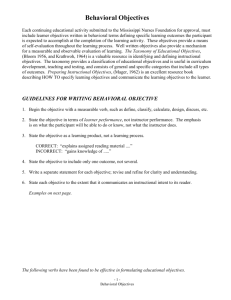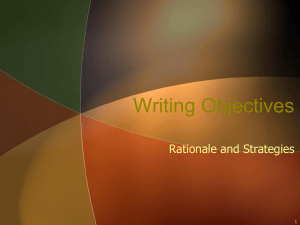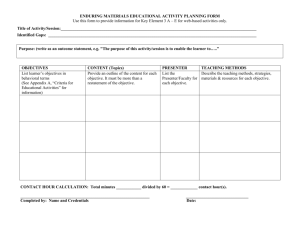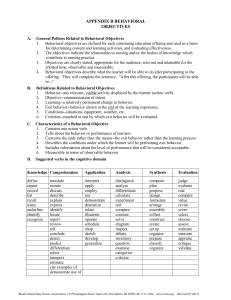Effective Curriculum and Instruction for Career Education
advertisement
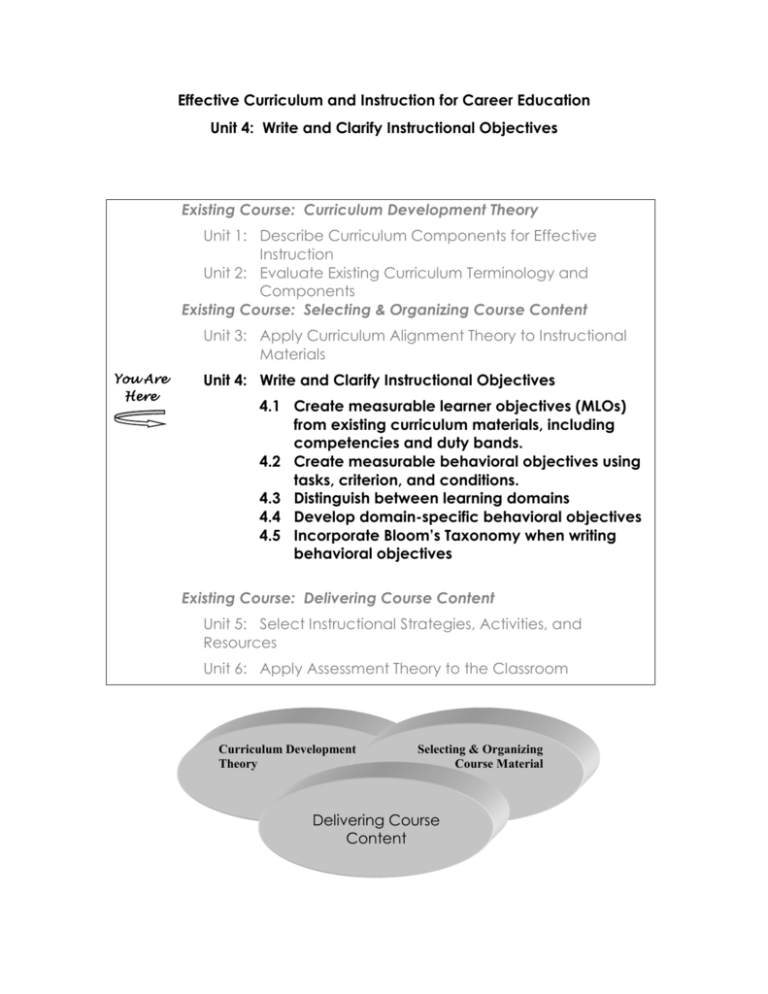
Effective Curriculum and Instruction for Career Education Unit 4: Write and Clarify Instructional Objectives Existing Course: Curriculum Development Theory Unit 1: Describe Curriculum Components for Effective Instruction Unit 2: Evaluate Existing Curriculum Terminology and Components Existing Course: Selecting & Organizing Course Content Unit 3: Apply Curriculum Alignment Theory to Instructional Materials You Are Here Unit 4: Write and Clarify Instructional Objectives 4.1 Create measurable learner objectives (MLOs) from existing curriculum materials, including competencies and duty bands. 4.2 Create measurable behavioral objectives using tasks, criterion, and conditions. 4.3 Distinguish between learning domains 4.4 Develop domain-specific behavioral objectives 4.5 Incorporate Bloom’s Taxonomy when writing behavioral objectives Existing Course: Delivering Course Content Unit 5: Select Instructional Strategies, Activities, and Resources Unit 6: Apply Assessment Theory to the Classroom Curriculum Development Theory Selecting & Organizing Course Material Delivering Course Content UNIT OF INSTRUCTION PLAN Name of Course: Effective Curriculum and Instruction for Career Education Measurable Learner Objective: Unit 4: Write and Clarify Instructional Objectives Duration of Unit: Weeks 5-7 (450 minutes) Rationale for Unit: Consistent with Unit 1’s attempt at clarifying terminology, Unit 4 will continue clarifying the many different definitions of “objectives” and how they relate to the classroom. It is important for teachers to write many different types of objectives, as well as be able to accurately communicate the objective’s intent with all stakeholders. An emphasis will be placed on transitioning a teacher’s existing curriculum from the “duty band/competency” format to a “measurable learner objectives and tasks” format. This may assist the teachers in creating more manageable internal and external alignments. In addition, this unit will emphasize creating behavioral objectives at the lesson plan level. Unit Task(s): 4.1 Create measurable learner objectives (MLOs) from existing curriculum materials, including competencies and duty bands. 4.2 Create measurable behavioral objectives using tasks, criterion, and conditions. 4.3 Distinguish between learning domains 4.4 Develop domain-specific behavioral objectives 4.5 Incorporate Bloom’s Taxonomy when writing behavioral objectives Topical Outline (content to be covered): Curriculum Objectives a. Theoretical discussions Readings (Mager, 1962; Miller & Miller, 2002; DESE Curriculum Sampler & GLEs, 2003; Finch & Crunkilton, 1999) b. Relationship among “objectives” (different types) Grade level expectations (GLEs) Course objectives Unit objectives Measurable learner objectives (MLOs) Behavioral objectives c. Behavioral objectives Components (task, condition, and criteria) Behavioral objectives: learning domain overview Behavioral objectives: cognitive Behavioral objectives: affective Behavioral objectives: psychomotor d. Linking behavioral objectives to all other objectives (measurable learner objectives, unit objectives, course objectives) e. Program area / content-specific materials TeachingLearning Activities: 1. Presentation/discussion 2. Critiquing existing curricula for measurable learner objectives and behavioral objectives for links to other materials 3. Writing sample/actual measurable learner objectives and behavioral objectives 4. Questions/answers/collaboration work Instructional Resources: 1. Teacher’s sample/actual curriculum 2. Course readings (instructor identified) 3. Presentation (digital file and slide handout) 4. Show-Me Administrators Curriculum Consortium 5. Missouri Center for Career Education Definitions (Appendix E). 6. Sample component items / worksheets 7. Computer and projector Facilities: 1. Classroom 2. Computer laboratory (teacher notebook computers) Assessment Activities: 1. Peer Assessment Checklist: Evaluating behavioral objective components (task, condition, criteria) 2. Teacher daily performance work (ongoing objective development) 3. Unit and final exam assessments (comprehension, application, and evaluation levels) Specialized Information: While the tasks presented for this unit will focus on measurable learner objectives and behavioral objectives designed to influence daily instruction at the lesson plan level, other types of objectives related to a course in general (course objectives) and broad student objectives that drive the curriculum development process (unit objectives) will also be discussed. It is imperative the teacher be able to differentiate among the different types of objectives, while at the same time see the relationship among all types of objectives for the instructional planning delivery process. Effective Curriculum and Instruction for Career Education Unit 4: Write and Clarify Instructional Objectives Suggested Lesson Plan Teacher: (to be determined) Subject Area: Career Education Curriculum Alignment Grade Level: Graduate University Credit (3.0 hours) Unit Title: Write and Clarify Instructional Objectives Lesson Title: 1. Theory and overview of curriculum objectives (Lesson 4a). 2. Transitioning to measurable learner objectives (MLOs) from other curriculum materials (Lesson 4b). 3. Writing behavioral objectives and linking them to the various types of “instructional objectives” (Lesson 4c). Behavioral Objectives: 1. When discussing multiple curriculum objectives, the teacher will differentiate among different types of objectives consistent with professional literature. 2. When planning their curriculum, the teacher will create effective course and unit objectives consistent with the professional literature. 3. Given their existing competencies and duty bands, the teacher will create course-specific measurable learner objectives (MLOs) consistent with DESE and course literature. 4. Given professional literature and class discussions, the teacher will create cognitive behavioral objectives consistent with Mager (1962). 5. Given professional literature and class discussions, the teacher will create affective behavior objectives consistent professional literature with Mager (1962). 6. Given and class discussions, the teacher will create psychomotor behavioral objectives consistent with Mager (1962). 7. While in the classroom, the teacher will be able to distinguish among behavioral objective components (task, condition, and criteria) with 100% accuracy. 8. When planning instructional materials, the teacher will appreciate the learning needs of their students as evidenced by addressing all three learning domains. Materials/Resources Needed: 1. Teacher’s sample/actual curriculum. 2. Selected Readings: Curriculum Development and Instructional Development (DESE Curriculum Sampler, 2003; DESE Grade Level Expectations Materials, 2004; Miller & Miller, 2002; Finch & Crunkilton, 1999; Mager, 1962). 3. Electronic presentation: ECICE Unit 4. 4. Guest presenters: Show-Me Administrators Curriculum Consortium. 5. Missouri Center for Career Education Definitions (Appendix E). 6. Sample component items / worksheets. 7. Domain/verb lists (Miller & Miller, 2002). 8. Computer and projector. Anticipatory Set: (Addressing measurable learner objectives versus competencies): Per Unit 3 of this course, how many of you are aligning your curriculum at the “competency” competencies do level? teachers How have many for their courses? (Emphasize Marketing Education and Trade and Industrial Education crosswalking at the MLO level.) (Addressing writing behavioral objectives): the lesson plan level, how do At teachers communicate their daily expectations of their students (lesson plan level)? Do the teachers communicate what they expect the students to “know”? Do the teachers communicate what they expect the students to “appreciate and feel?” Do the teachers communicate what they expect the students to “do”? Do the teachers communicate what the students will be accomplishing during this course (course objectives)? Do the teachers communicate what the students will be accomplishing during the unit (unit objectives)? Do the teachers link all of their different types of objectives to DESE’s Grade Level Expectations (GLEs) for their content areas? Objective/Purpose: Relay to teachers….”It’s important for us to be able to differentiate among the many different types of ‘objectives’ (per Unit 1 of this curriculum). It’s also very important for us to be able to communicate at the lesson plan level what we expect students to know/feel/do (task), how they’ll be assessed (condition), and how well we expect them to perform or what standard we’ll assess them against (criteria). In addition, it is important to recognize the massive amount of curricular alignment (internal and external alignment) required at the competency level and how this unit can introduce you to aligning at the ‘measurable learner objective’ level as discussed in Units 1, 2, and 3.” Input: 1. Teachers should provide their existing curriculum that has been modified based on Units 1 and 2, (including their main measurable learner objectives), as well as their notes/plans on curriculum alignment alignment. will “begin” Since with the curriculum planning surrounding the MLOs and GLEs, the teachers must begin thinking how they will address the MLOs and GLEs at the lesson level (instructional strategies, resources needed, and assessments). Model: Instructor-led discussion Teacher/peer collaboration Question and answers Guest presenters: Show-Me Administrators Curriculum Consortium Model ECICE measurable learner objectives that drive Unit 4 and future units (Unit 5: Strategies/ Activities/Resources and Unit 6; Assessments) Check for Understanding: 1. Multiple types of “objectives” teachers use: a. Those at the “course” level (course objectives). b. Those at the “unit” level (MLOs). c. Those at the “lesson plan” level (behavioral objectives). 2. Newer terms some teachers may not be familiar with: a. Measurable learner objectives (MLOs). b. Grade-level expectations (GLEs). c. Guest presenters from the Missouri Show-Me Administrators Curriculum Consortium will provide insight. 3. Behavioral objectives: a. Behavioral objectives at the lesson level must relate to the objectives at the “macro” level (MLOs, unit objectives, course objectives, GLEs). b. Different types of behavioral objectives: cognitive, affective, and psychomotor. c. Different components of behavioral objectives: task, condition, criteria. d. Based on Mager’s work (1962): must tie to the bigger picture as they communicate what the students must do, how they’ll do it, and how well we expect them to perform. Strong link to Unit 3 (curriculum alignment). e. Each learning domain incorporates specific verbs (some overlap). Much planning must go into determining which verbs best communicate the lesson’s expectations. f. Each domain has its challenges, but the most difficult domain may be the affective domain. Psychomotor objectives may not be applicable depending on the content. g. When writing behavioral objectives, it may be helpful to simply write three phrases: what the students will do, how they will accomplish it, and how well (to what standard) they will be expected to perform. The phrases can then be arranged to form a meaningful sentence consistent with the literature (condition, task, criteria). Guided Practice: 1. Teachers critique their existing objectives, identifying the types of objectives illustrated. 2. Teachers critique their partner’s objectives, identifying the types of objectives illustrated. 3. If the MLO format is consistent with their DESE content area recommendations and school district requirements, the teachers will begin transitioning from the competency/duty band format to the measurable learner objective format (Appendix E). 4. If teachers have not created behavioral objectives, use class handouts to create two objectives in each domain (psychomotor objective may not be applicable). Closure: 1. Objectives: Many different types, but all within the same unit should be related to the macro level objectives. 2. MLOs versus competencies/duty bands: Which is best for the teacher regarding curriculum alignment, DESE recommendations, and/or school district requirements? 3. Behavioral objectives are delivered at the lesson plan level, and can guide instruction in three domains (cognitive, affective, psychomotor). Psychomotor objective may not be applicable. 4. Behavioral objectives have three components (task, condition, criteria). Independent Practice: 1. Read all materials disseminated in class (theory, DESE documents, samples, etc.). 2. If consistent with their DESE content area recommendations and local district requirements, teachers begin transitioning their existing competencies and duty bands to measurable learner objectives (Appendix E). 3. Teachers choose one unit of instruction from their existing curriculum and identify or create their “macro” objectives (MLOs, unit objectives, course objectives, etc.) and use that MLO for their internal and external alignment starting point. 4. Based on that unit, choose one lesson plan and create behavioral objectives that if met will support the appropriate “macro” objectives (psychomotor applicable). objective may not be Effective Curriculum and Instruction for Career Education Unit 4: Write and Clarify Instructional Objectives Program Area Specific Examples The following curriculum samples will be presented during this Unit of Instruction. Additional samples relating to this unit may be found in Units 1 and 2. Also, additional samples will be presented as needed depending on the class population for any given semester. Example 1: Business Education’s Business Technology (2004) Course, Explore Careers in Business Unit Overview. (Example purpose: The “Explore Careers in Business” Unit provides an overview that includes a unit goal and measurable learner objectives. These measurable learner objectives are also stated as competencies on the Business Technology competency profile as indicated by the competency letter/number listed at the end of the measurable learner objective. While behavioral objectives (lesson plan level) are not provided on the overview, adequate information in the Explore Careers in Business Unit should assist business education teachers create appropriate behavioral objectives. In addition, internal and external alignments, instructional activities, and assessments are included on the unit overview, which are appropriate examples for units three, five, and six of this curriculum guide. Program Area Specific Examples: Business Education Business Technology Explore Careers in Business Unit Overview EXPLORE CAREERS IN BUSINESS Overview GOAL: Students will evaluate career opportunities in business and prepare a written career development plan utilizing assessment tools and analyzing career data. Measurable Learner Objectives Utilize career assessment tools (e.g., student interest survey, aptitude test). A1 Analyze various business careers by looking at salary, benefits, job requirements, educational requirements, employment outlook, etc. A2 Research career choice. A3 Prepare a career development plan. A3 Access information from professional, technical, and electronic resources. D6 Use correct grammar, spelling, and punctuation. D1 Crosswalk to ShowMe Standards CA1, 1.10 CA3, 4.8 CA5, 1.2 CA3, 4.8 CA3, 1.4 CA1, 2.2 Instructional Activities Assessment Utilize career assessment tools to determine career interests and select several business careers to research. Using the Occupational Outlook Handbook (OOH) and similar sources, answer questions on selected careers to determine salaries; training, duties and responsibilities, qualifications of persons working in career; educational requirements; opportunities for advancement; and future outlook. Narrow your decision to one career area and write a career development plan that depicts timelines and specifies activities to achieve career goal. Use assessment Explore Careers in Business to evaluate the career development plan based on activities to be conducted along the timeline from current status to perceived career goal. Also assess evidence of information collected during the career assessment and career research stages: use of assessment tools and resources for career research. Accuracy of grammar, spelling and punctuation in writing will also be assessed. Effective Curriculum and Instruction for Career Education Unit 4: Write and Clarify Instructional Objectives Suggested Unit Assessment Measurable Learner Objective: Behavioral Objective: Write and Clarify Instructional Objectives 1. When discussing multiple curriculum objectives, the teacher will differentiate among different types of objectives consistent with professional literature. 2. When planning their curriculum, the teacher will create effective course and unit objectives consistent with the professional literature. 3. Given their existing competencies and duty bands, the teacher will create course-specific measurable learner objectives (MLOs) consistent with DESE and course literature. 4. Given professional literature and class discussions, the teacher will create cognitive behavioral objectives consistent with Mager (1962). 5. Given professional literature and class discussions, the teacher will create effective behavior objectives consistent with Mager (1962). 6. Given professional literature and class discussions, the teacher will create psychomotor behavioral objectives consistent with Mager (1962). 7. While in the classroom, the teacher will be able to distinguish among behavioral objective components (task, condition, and criteria) with 100% accuracy. 8. When planning instructional materials, the teacher will appreciate the learning needs of their students as evidenced by addressing all three learning domains. Learning Domain(s): Assessments: Cognitive and Affective 1. Peer Assessment Checklist: objective components (task, evaluate behavioral condition, criteria; analysis and evaluation level). 2. Teacher daily performance work (ongoing objective development). 3. Unit and final exam assessments (comprehension and application level). Peer Assessment: Evaluating Behavioral Objectives Bloom’s Taxonomy Cognitive Levels Assessed: Analysis and Evaluation Evaluate an identified curriculum of your choice (or materials developed in class) for behavioral objectives using the following checklist. Analyze and evaluate the component in the left-hand column against the criteria at the right. Behavioral Objective Components Task Criteria (Binary Assessment: Yes or No) Clearly states what the student will know (cognitive), feel/appreciate (affective), or do (psychomotor). Only states one measurable task (not multiple tasks within one objective). Verb choice (Miller & Miller, 2002) is consistent with MLO Verb choice (Miller & Miller, 2002) is consistent with unit objective. Verb choice (Miller & Miller, 2002) is consistent with learning domain specified. Other: Condition Clearly states in what environment the student will be performing (written exam, in the lab, etc.). Indicates what materials the students may use (Optional: “Given the appropriate laboratory equipment,” etc.). Avoids using “time” components as a condition (“At the end of this lesson,” etc.). Other: Criteria Clearly states the required knowledge or performance (“with 100% accuracy”, “per manufacturer’s specifications”, etc.) Other: Unit and Final Exam Assessments: Potential Assessment Items Bloom’s Taxonomy Cognitive Levels Assessed: Comprehension and Evaluation On a typed/word processed document to be attached to this sheet, choose one duty band and corresponding competencies from your content area competency profile and address the following questions/issues: 1. How is the current duty band stated (complete sentence? topic only?). 2. Is the duty band “measurable” using the appropriate verb? If not, restate the duty band into a measurable learner objective. 3. How many competencies are currently listed under the duty band? 4. What issues must be discussed if the duty band is transitioned to a measurable learner objective? (e.g., tracking competency attainment; 80%/80%; school district policy/requirements; DESE requirements/ recommendations). 5. What are the benefits band/competency” of format transitioning to the from the “measurable “duty learner objective/task” format? 6. What are the concerns band/competency” format objective/task” format? of transitioning to the from the “measurable “duty learner Unit and Final Exam Assessments: Potential Assessment Items Bloom’s Taxonomy Cognitive Levels Assessed: Comprehension and Application On a typed/word processed document to be attached to this sheet, choose one of the following MLOs to create the components (task, condition, criteria) for a cognitive behavioral objective, an affective behavioral objective, and a psychomotor behavioral objective for the lesson plan level. You may use the following resources in your work: Verb list (Miller and Miller, 2002) Learner Objective: The student will disassemble and reassemble a personal computer “CPU” at the component level (within the main box). TASK CONDITION CRITERIA COGNITIVE: AFFECTIVE: PSYCHOMOTOR: Stated Objectives (Sentences): Learner Objective: The student will create employability documents. TASK COGNITIVE: AFFECTIVE: PSYCHOMOTOR: Stated Objectives (Sentences): CONDITION CRITERIA
